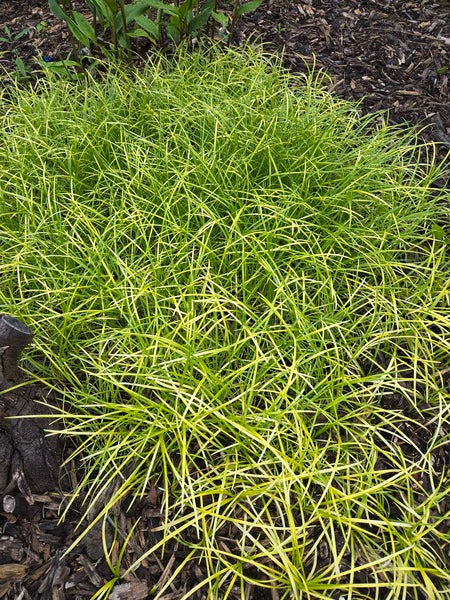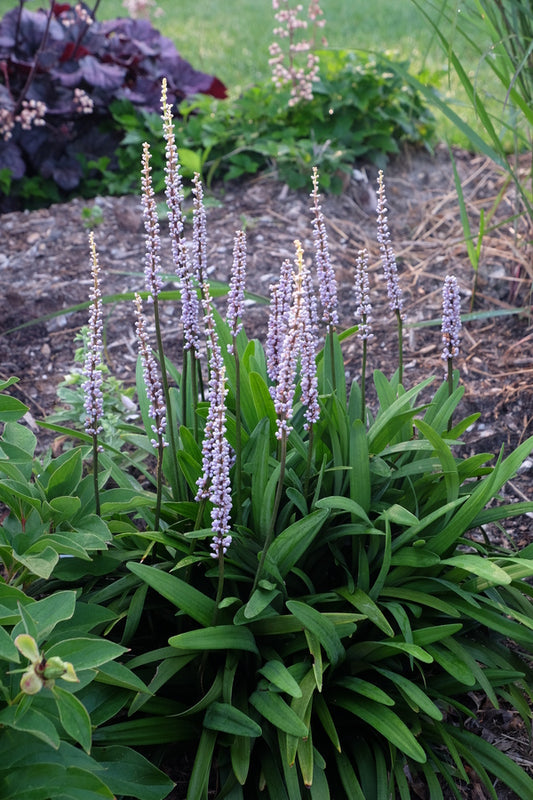Liriope is a tough-as-nails, drought-tolerant member of the lily family that can be grown in sun or shade, and in moist or dry sites. It is a tough, low maintenance plant which makes it perfect for rain gardens.
-
Liriope gracilis 'Mop Top'
Item #: 11801
Zones: 6a to 9b, guessing
Dormancy: Evergreen
Height: 15" tall
Culture: Part Sun to Light Shade
Origin: China
Pot Size: 3.5" pot (24 fl. oz/0.7 L)
Regular price $25.00Regular priceUnit price per -
Liriope minor 'Gotemba Gold'
Item #: 18293
Zones: 6a to 10a
Dormancy: Evergreen
Height: 3" tall
Culture: Part Sun to Shade
Origin: Japan
Pot Size: 3.5" pot (24 fl. oz/0.7 L)
Regular price $23.00Regular priceUnit price per -
Liriope muscari 'Peedee Ingot'
Item #: 3096
Zones: 6a to 10b
Dormancy: Evergreen
Height: 18" tall
Culture: Part Sun to Light Shade
Origin: China, Japan, Taiwan
Pot Size: 3.5" pot (24 fl. oz/0.7 L)
Regular price $25.00Regular priceUnit price per -
Liriope platyphylla 'Peter's Pick'
Item #: 13042
Zones: 5a to 10b, guessing
Dormancy: Evergreen
Height: 9" tall
Culture: Part Sun to Light Shade
Origin: China
Pot Size: 3.5" pot (24 fl. oz/0.7 L)
Regular price $26.00Regular priceUnit price per
More Information About Liriope
Liriope is one of the most ubiquitous garden plants in the southeast, however, gardeners have only scratched the surface of these easy-to-grow perennials. It is a tough-as-nails, drought-tolerant member of the lily family that can be grown in sun or shade, and in moist or dry sites. Although not a true ornamental grass, its habit is very grass-like and it is often lumped together with them. Liriope looks very similar to ophiopogon and the two are often used the same way in gardens, but usually not together.
We strive to offer some of the more fascinating and unusual liriope species that we have acquired from plant hunting expeditions and from breeders worldwide.
Plant Delights Nursery is the nation's foremost nursery for liriope. We grow more species and cultivars than any other nursery in the world and in 2015 we worked with Dr. Paul Fantz of NC State University to publish an award winning journal article describing liriopes grown in the US.
How to Grow Liriope (Monkey Grass)
Design Considerations: Liriope is generally used as an edging plant along borders, beds, and paths. It is also used (especially the spreading forms) as a bed filler and groundcover. Liriope also makes a tough and easy to grow container plant. Its tolerance of air pollution makes it a great choice for cities too. It is evergreen, it looks a little like real grass, and is tolerant of harsher growing conditions, but liriope does not tolerate foot traffic so it is not a good turf substitute. It is a great low maintenance plant for hillside erosion control. Variegated liriope can be used to lighten up an area.
Soil: Any kind except waterlogged. Well-drained is better than poorly drained.
Water: Drought tolerant, but regular watering during the spring and summer keeps it looking its best.
Sun: Sun or shade. Growth is best in part sun.
Fertilizer: Does not need much fertilizer. A single application of compost in the spring is enough to feed it for the year.
Pruning: Old foliage and stressed out plants can look ratty. To keep your liriope looking fresh, mow or trim it to 3" tall in the early spring and the new foliage will quickly sprout and look good all year long.
Pests: Deer and Rabbits do not eat it. Most insects leave it alone. Sometimes you will see scale or slugs on it. Too much rain or overhead can cause reddish leaf spots or brown leaf tips that are ugly but will not kill the plant. This is a disease called anthracnose and you should cut the diseased foliage and remove it from the area. The same mowing treatment used to prune the plants will also work in this situation. Too much water can trigger root rot and if that happens the affected plant should be discarded...but it is easy to avoid.








